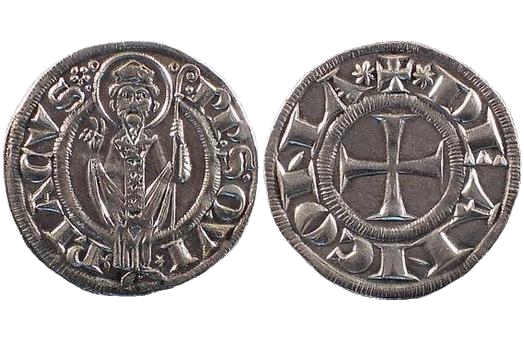
about ancient nomos
Ancient Nomos Art is a museum of galleries exhibiting ancient coins and ancient mint maps. The coin gallery displays the diverse art and history of hand-crafted ancient Greek, Roman, Byzantine, Persian and Medieval coinage. The ancient mints mapping gallery features Greek, Roman, Byzantine, Asia Minor and Medieval mint city regions and territories. Visitor's are welcome to explore, study and enjoy Ancient Nomos Art.

Medieval, Ancona – 1250 AD
Ancona, Italy
From Ancient Galleries

Obverse: Cross pattée in center, legend between spiral inner and outer circles.
Reverse: St. Cyriacus seated facing, holds crozier, hand raised in benediction.
LEGEND
Obv. + (star) DE ANCONA (star), Cross pattee in center with circular border. Rev. • PP • S • QVI (star) • (trefoil) RIACVS • (rose), Saint Judas Cyriacus seated facing, holding crozier in left hand and raising right hand in benediction .
The Republic of Ancona prospered during the rise of the Middle Ages and subsequant decline of late Byzantium. Ancona is located along the northeast coast of Italy. During the twelfth century, some of the Italian cities located adjacent to the Holy Roman Empire were able to launch successful efforts to win autonomy in the region. This effort soon made Ancona one of Italy’s many quasi-independent city-states right up to the nineteenth century. As an important northern Italian port city, Ancona survived the fall of the Roman Empire in the West, and by the tenth century was strong enough to resist the attacks from North Africa and then counterattacks under the leadership of the bishops from Rome. Maritime commerce was the city’s dominant activity. By the twelfth and thirteenth centuries, Ancona played a leading role in the nascent European commercial revolution. With growing economic power in the Aegean seas and a mercantile enterprise rivaled only by Venice, its commercial network spread toward the East. The Republic of Ancona had honored a certain Judas Cyriacus as its patron saint. Local tradition claims that Cyriacus (or Quiriacus) was Jewish and from Jerusalem. Claims were made that he had a fateful meeting with the Roman empress Helena around 327 AD. Helena, mother of Constantine the Great, was on a pilgrimage to Jerusalem when she encountered Cyriacus, who revealed to her the location of the True Cross upon which Christ was crucified. After guiding the empress to the holy relic, Cyriacus converted to Christianity and became a Bishop of Jerusalem, only to suffer martyrdom years later under Julian the Apostate. The city of Ancona is said to have received his saintly relics, but not his head, under another empress, Galla Placidia, around the middle of the fifth Century. He has been the city’s patron Saint ever since. His head still rests in a church in the town of Provins, France, compliments of Henry de Champagne, who brought it from Jerusalem during the Crusades. The feast of Cyriacus is still celebrated on May 4th.
DOCUMENTATION
Value: Grosso Angontano. Metal: AR Silver. Weight: 2.39 grams. Mint: Ancona. Date:13th Century.
Attribution: Corpus Nummorum Italicorum, XIII 23; Biaggi. Monete e Zecche Medievali Italiane, 34.
Legend, Documentation and Attribution
